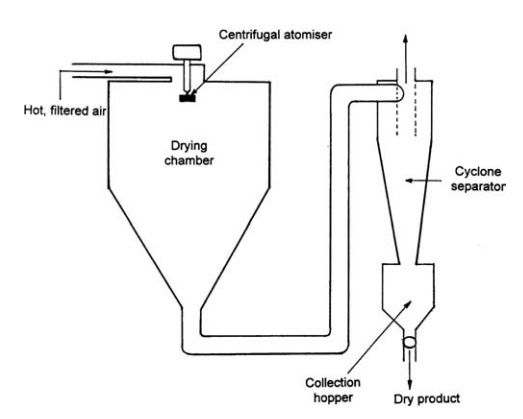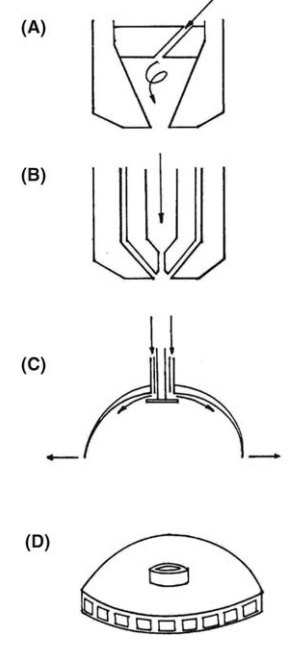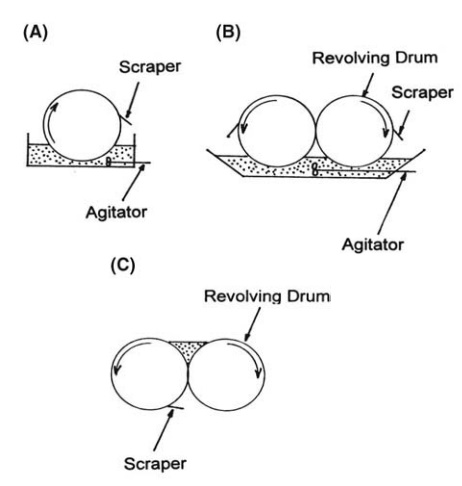Continuous Dryers
| Home | | Pharmaceutical Technology |Chapter: Pharmaceutical Engineering: Drying
Continuous Dryers : Spray Dryers, Drum Dryers
CONTINUOUS DRYERS
Although
many types of continuous dryers are available, the scale of the operation for
which they are designed is rarely appropriate for pharmaceutical manufacture.
As with most continuous plant items, the cost is dis-proportionately high for
small units. Spray and drum dryers provide an exception to this comment because
residence times in the dryers are short and thermal degradation is minimized.
Under some conditions, freeze-drying may be the only practicable alternative.
Spray Dryers
As
the name implies, the solution or suspension to be dried is sprayed into a hot
airstream and circulated through a chamber. The dried product may be carried
out to cyclone or bag separators or may fall to the bottom of the drying
chamber and be expelled through a valve. The chambers are normally cylindrical
with a conical bottom, although proportions vary widely. A typical spray dryer
is illustrated in Figure 7.11 (Masters, 1991; Sacchetti and Van Oort, 2006).

FIGURE 7.11 Spray
dryer.

FIGURE 7.12 Schematic diagrams of atomizers
for spray drying.
The
process can be divided into four sections: atomization of the fluid, mixing of
the droplets, drying, and, finally, removal and collection of the dry
particles.
Atomization
may be achieved by means of single fluid or two fluid nozzles or by spinning
disk atomizers. The single fluid nozzle, illustrated in Figure 7.12, operates
by forcing the solution under pressure through a fine hole into the airstream.
An intense swirl is conferred on the liquid before it emerges from the orifice.
This causes the jet to break up. In the two fluid nozzles, shown in Figure
7.12, a jet of air simultaneously emerges from an annular aperture con-centric
with the liquid orifice. Both types are subject to clogging and severe erosion,
so neither is well suited to spraying suspensions. The spinning disks are most
versatile and consist, in their simplest form, of a mushroom-shaped disk
spinning at 5000 to 30,000 rpm. Other designs include the slotted disk (Fig.
7.12), which will spray thick suspensions and, if special feeding arrangements
are used, pastes. The main factors that determine the size of the droplets are
the viscosity and surface tension of the liquid, the fluid pressure in the use
of nozzles, or, for spinning disks, their size and speed of rotation. A
reasonably uniform and controllable size within the range 10 to 500 μm is desirable.
In
vertical spray dryers, the flow of the drying gas may be concurrent or
countercurrent with respect to the movement of droplets. The movement of the
gas is, however, complex and highly turbulent. Good mixing of droplets and gas
occurs, and the heat and mass transfer rates are high. In conjunction with the
large interfacial area conferred by atomization, these factors give very high
evaporation rates. The residence time of a droplet in the dryer is only a few
seconds (5–30 seconds). Since the material is at wet bulb temperature for much
of this time, high gas temperatures of 150○C to 200○C may be used even
with thermolabile materials. Although the temperature of the material rises
above the wet bulb temperature at the end of the process, the drying gases will
be cooler and the material will be almost dry, a condition in which many
materials are thermally less sensitive. For these reasons, it is possible to
dry complex vege-table extracts, such as coffee or digitalis, milk products,
spore suspensions, and other labile materials without significant loss of
potency or flavor.
Drying
is considered to take place by simple evaporation rather than by boiling, and
it has been observed that a droplet reaches a terminal velocity within about 30
cm of the atomizer. Beyond this, there is no relative velocity between the
droplet and the drying gas unless the former is very large. The droplets may
dry to form a solid, spherical particle. If, however, the emerging solids form
a skin, internal pressure may inflate the particle, and the final dry form will
be hollow spheres that may or may not have a blow hole. These xenospheres may
also fragment so that the final product occurs as agglomerates of finely
divided solids. It has been found experimentally that the product’s bulk
density, which is lowest for xenospheres and highest for fragmented solids,
increases as the inlet air temperature is lowered and as the drop size
increases. A higher feed concentration also increases the bulk density because
drops of the same size give spheres with thicker walls.
These
attractive physical characteristics lend further advantage to spray drying. The
product often has excellent flow and packing properties that greatly facilitate
handling and transport. As an example, spray-dried lactose is a widely used
tablet excipient, which will flow, pack, and compact without prior
gran-ulation. Similarly, a slurry of fillers and other excipients could be
granulated by spraying and drying. After adding an active principle, the mix
could be com-pressed without further processing.
The
capital and running costs of spray dryers are high, but if the scale is
sufficiently large, they may provide the cheapest method. When thermolabile
materials are dried on a small scale, costs will be 10 to 20 times greater than
that for oven drying. Air used to dry fine chemicals or food products is heated
indirectly, thus reducing thermal efficiency and increasing costs. In some
other installations, hot gases from combustion may be used directly.
Drum Dryers
The
drum dryer consists of one or two slowly rotating, steam-heated cylinders.
These are coated with solution or slurry by means of a dip feed, illustrated in
Figure 7.13, in which the lower portion of the drum is immersed in an agitated
trough of feed material or, in the case of some double drum dryers, by feeding
the liquor into the gap between the cylinders, as shown in Figure 7.13. Spray
and splash feeds are also used. When dip feeding is employed, the hot drum must
not boil the liquid in the trough. Drying takes place by simple evaporation
rather

FIGURE 7.13 Drum dryers.
Drying
capacity is influenced by the speed of the drum and the temper-ature of the
feed. The latter may be preheated. With the double drum dryer, the gap between
the cylinders determines the thickness of the film.
Drum
dryers, like spray dryers, are relatively expensive in small sizes, and their
use in the pharmaceutical industry is largely confined to drying thermo-labile
materials where the short contact time is advantageous. Drums are nor-mally
fabricated from stainless or chrome-plated steel to reduce contamination. The
heat treatment to which the solid is subjected is greater than that in spray
drying, and the physical form of the product is often less attractive. During
drying, the liquid approaches its boiling point and the dry solids approach the
temperature of the drum surface.
Related Topics
